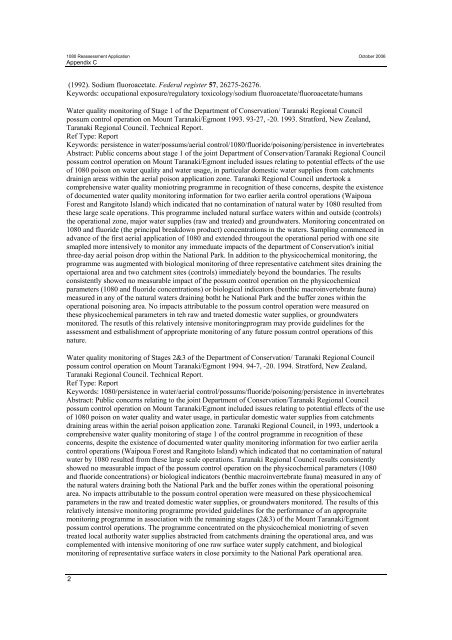Source: Landcare Research (1964). Control of poisons. Royal ...
Source: Landcare Research (1964). Control of poisons. Royal ...
Source: Landcare Research (1964). Control of poisons. Royal ...
You also want an ePaper? Increase the reach of your titles
YUMPU automatically turns print PDFs into web optimized ePapers that Google loves.
1080 Reassessment Application October 2006<br />
Appendix C<br />
(1992). Sodium fluoroacetate. Federal register 57, 26275-26276.<br />
Keywords: occupational exposure/regulatory toxicology/sodium fluoroacetate/fluoroacetate/humans<br />
Water quality monitoring <strong>of</strong> Stage 1 <strong>of</strong> the Department <strong>of</strong> Conservation/ Taranaki Regional Council<br />
possum control operation on Mount Taranaki/Egmont 1993. 93-27, -20. 1993. Stratford, New Zealand,<br />
Taranaki Regional Council. Technical Report.<br />
Ref Type: Report<br />
Keywords: persistence in water/possums/aerial control/1080/fluoride/poisoning/persistence in invertebrates<br />
Abstract: Public concerns about stage 1 <strong>of</strong> the joint Department <strong>of</strong> Conservation/Taranaki Regional Council<br />
possum control operation on Mount Taranaki/Egmont included issues relating to potential effects <strong>of</strong> the use<br />
<strong>of</strong> 1080 poison on water quality and water usage, in particular domestic water supplies from catchments<br />
drainign areas within the aerial poison application zone. Taranaki Regional Council undertook a<br />
comprehensive water quality moniotring programme in recognition <strong>of</strong> these concerns, despite the existence<br />
<strong>of</strong> documented water quality monitoring information for two earlier aerila control operations (Waipoua<br />
Forest and Rangitoto Island) which indicated that no contamination <strong>of</strong> natural water by 1080 resulted from<br />
these large scale operations. This programme included natural surface waters within and outside (controls)<br />
the operational zone, major water supplies (raw and treated) and groundwaters. Monitoring concentrated on<br />
1080 and fluoride (the principal breakdown product) concentrations in the waters. Sampling commenced in<br />
advance <strong>of</strong> the first aerial application <strong>of</strong> 1080 and extended througout the operational period with one site<br />
smapled more intensively to monitor any immeduate impacts <strong>of</strong> the department <strong>of</strong> Conservation's initial<br />
three-day aerial poison drop within the National Park. In addition to the physicochemical monitoring, the<br />
programme was augmented with biological monitoring <strong>of</strong> three representative catchment sites draining the<br />
opertaional area and two catchment sites (controls) immediately beyond the boundaries. The results<br />
consistently showed no measurable impact <strong>of</strong> the possum control operation on the physicochemical<br />
parameters (1080 and fluoride concentrations) or biological indicators (benthic macroinvertebrate fauna)<br />
measured in any <strong>of</strong> the natural waters draining botht he National Park and the buffer zones within the<br />
operational poisoning area. No impacts attributable to the possum control operation were measured on<br />
these physicochemical parameters in teh raw and traeted domestic water supplies, or groundwaters<br />
monitored. The resutls <strong>of</strong> this relatively intensive monitoringprogram may provide guidelines for the<br />
assessment and estbalishment <strong>of</strong> appropriate monitoring <strong>of</strong> any future possum control operations <strong>of</strong> this<br />
nature.<br />
Water quality monitoring <strong>of</strong> Stages 2&3 <strong>of</strong> the Department <strong>of</strong> Conservation/ Taranaki Regional Council<br />
possum control operation on Mount Taranaki/Egmont 1994. 94-7, -20. 1994. Stratford, New Zealand,<br />
Taranaki Regional Council. Technical Report.<br />
Ref Type: Report<br />
Keywords: 1080/persistence in water/aerial control/possums/fluoride/poisoning/persistence in invertebrates<br />
Abstract: Public concerns relating to the joint Department <strong>of</strong> Conservation/Taranaki Regional Council<br />
possum control operation on Mount Taranaki/Egmont included issues relating to potential effects <strong>of</strong> the use<br />
<strong>of</strong> 1080 poison on water quality and water usage, in particular domestic water supplies from catchments<br />
draining areas within the aerial poison application zone. Taranaki Regional Council, in 1993, undertook a<br />
comprehensive water quality monitoring <strong>of</strong> stage 1 <strong>of</strong> the control programme in recognition <strong>of</strong> these<br />
concerns, despite the existence <strong>of</strong> documented water quality monitoring information for two earlier aerila<br />
control operations (Waipoua Forest and Rangitoto Island) which indicated that no contamination <strong>of</strong> natural<br />
water by 1080 resulted from these large scale operations. Taranaki Regional Council results consistently<br />
showed no measurable impact <strong>of</strong> the possum control operation on the physicochemical parameters (1080<br />
and fluoride concentrations) or biological indicators (benthic macroinvertebrate fauna) measured in any <strong>of</strong><br />
the natural waters draining both the National Park and the buffer zones within the operational poisoning<br />
area. No impacts attributable to the possum control operation were measured on these physicochemical<br />
parameters in the raw and treated domestic water supplies, or groundwaters monitored. The results <strong>of</strong> this<br />
relatively intensive monitoring programme provided guidelines for the performance <strong>of</strong> an appropraite<br />
monitoring programme in association with the remaining stages (2&3) <strong>of</strong> the Mount Taranaki/Egmont<br />
possum control operations. The programme concentrated on the physicochemical moniotring <strong>of</strong> seven<br />
treated local authority water supplies abstracted from catchments draining the operational area, and was<br />
complemented with intensive monitoring <strong>of</strong> one raw surface water supply catchment, and biological<br />
monitoring <strong>of</strong> representative surface waters in close porximity to the National Park operational area.<br />
2








![Application for test certificate [pdf, 131kb]](https://img.yumpu.com/50666502/1/184x260/application-for-test-certificate-pdf-131kb.jpg?quality=85)








